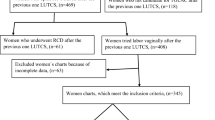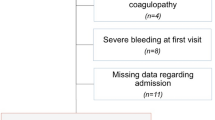Abstract
Objective:
Determine the impact of gestational age (GA) on vaginal delivery following induction of labor (IOL) for pre-eclampsia, and evaluate factors that influence successful induction.
Study Design:
Population-based retrospective cohort of 1 034 552 live births in Ohio (2006–2012). The rate of vaginal delivery in women with pre-eclampsia who underwent induction was calculated with 95% confidence intervals, stratified by week of GA at birth. Factors associated with the decision to undergo IOL, and success of IOL were evaluated, and multivariable logistic regression estimated the strength of association.
Results:
18 296 (71.3%) of the patients who underwent IOL had a vaginal delivery. The majority achieved vaginal delivery at both preterm (66% at 23–36 weeks) and term GAs (72%). Factors most strongly associated with vaginal delivery following IOL for pre-eclampsia included prior vaginal delivery and young maternal age.
Conclusion:
The majority of women with pre-eclampsia who undergo IOL achieve vaginal birth, even at early GAs.
This is a preview of subscription content, access via your institution
Access options
Subscribe to this journal
Receive 12 print issues and online access
$259.00 per year
only $21.58 per issue
Buy this article
- Purchase on Springer Link
- Instant access to full article PDF
Prices may be subject to local taxes which are calculated during checkout

Similar content being viewed by others
References
ACOG Task Force on Hypertension in Pregnancy. Hypertension in pregnancy: Report Of The American College of Obstetricians and Gynecologists' Task Force On Hypertension In Pregnancy. Obstet Gynecol 2013; 122: 1122.
Zuspan FP, Talledo E . Factors affecting delivery in eclampsia: the condition of the cervix and uterine activity. Am J Obstet Gynecol 1968; 100: 672–685.
Sibai BM . Diagnosis and management of gestational hypertension and preeclampsia. Obstet Gynecol 2003; 102 (1): 181–192.
Kim LH, Cheng YW, Delaney S, Jelin AC, Caughey AB . Is preeclampsia associated with an increased risk of cesarean delivery if labor is induced? J Matern Fetal Neonatal Med 2010; 23 (5): 383–388.
Blackwell SC, Redman ME, Tomlinson M, Landwehr JB Jr, Tuynman M, Gonik B et al. Labor induction for the preterm severe pre-eclamptic patient: is it worth the effort? J Matern Fetal Med 2001; 10: 305–311.
Coppage KH, Polzin WJ . Severe preeclampsia and delivery outcomes: is immediate cesarean delivery beneficial? Am J Obstet Gynecol 2002; 186: 921–923.
Nassar AH, Adra AM, Chakhtoura N, Gomez-Marin O, Beydoun S . Severe preeclampsia remote from term: labor induction or elective cesarean delivery? Am J Obstet Gynecol 1998; 179: 1210–1213.
Alanis MC, Robinson CJ, Hulsey TC, Ebeling M, Johnson DD . Early-onset severe preeclampsia: induction of labor vs. elective cesarean delivery and neonatal outcomes. Am J Obstet Gynecol 2008; 199: 262.e1–262.e6.
National Center for Health Statistics 2012 Guide to completing the facility worksheets for the certificate of live birth and report of fetal death (2003 revision). Hyattsville, MD: US Department of Health and Human Services, Centers for Disease Control and Prevention. Available at http://www.cdc.gov/nchs/data/dvs/GuidetoCompleteFacilityWks.pdf. Accessed on August 2015.
Rasmussen KM, Yaktine AL . Weight Gain during Pregnancy: Reexamining the Guidelines. National Academies: Washington, DC, USA, 2009.
Alexander GR, Himes JH, Kaufman RB, Mor J, Kogan M . A United States national reference for fetal growth. Obstet Gynecol 1996; 87 (2): 163–168.
Feghali M, Timofeev J, Huang CC, Driggers R, Miodovnik M, Landy HJ et al. Preterm induction of labor: predictors of vaginal delivery and labor curves. Am J Obstet Gynecol 2015; 212 (1): 91.e1–91.e7.
Pare E, McElrath TF, Pucci D, Newton A, Lim KH . Clinical risk factors for preeclampsia in the 21st century. Obstet Gynecol 2014; 124 (4): 763–770.
Magann EF, Roberts WE, Perry KG Jr, Chauhan SP, Blake PG, Martin JN Jr . Factors relevant to mode of preterm delivery with syndrome of HELLP (hemolysis, elevated liver enzymes, and low platelets). Am J Obstet Gynecol 1994; 170 (6): 1828–1832.
Ananth CV, Vintzileos AM . Maternal-fetal conditions necessitating a medical intervention resulting in preterm birth. Am J Obstet Gynecol 2006; 195: 1557–1563.
Bailit JL, for the Ohio Perinatal Quality Collaborative. Rates of labor induction without medical indication are overestimated when derived from birth certificate data. Am J Obstet Gynecol 2010; 203: 269.e1–269.e3.
Meis PJ, Goldenberg RL, Mercer BM, Iams JD, Moawad AH, Miodovnic M et al. The term prediction study: risk factors for indicated preterm births. Am J Obstet Gynecol 1998; 178: 562–567.
Acknowledgements
Perinatal Institute, Cincinnati Children’s Hospital Medical Center, Cincinnati, OH, USA; March of Dimes Grant 22-FY14-470.
Author information
Authors and Affiliations
Corresponding author
Ethics declarations
Competing interests
The authors declare no conflict of interest.
Rights and permissions
About this article
Cite this article
Roland, C., Warshak, C. & DeFranco, E. Success of labor induction for pre-eclampsia at preterm and term gestational ages. J Perinatol 37, 636–640 (2017). https://doi.org/10.1038/jp.2017.31
Received:
Revised:
Accepted:
Published:
Issue Date:
DOI: https://doi.org/10.1038/jp.2017.31
This article is cited by
-
The risk of cesarean delivery after labor induction among women with prior pregnancy complications: a subgroup analysis of the AFFIRM study
BMC Pregnancy and Childbirth (2019)



